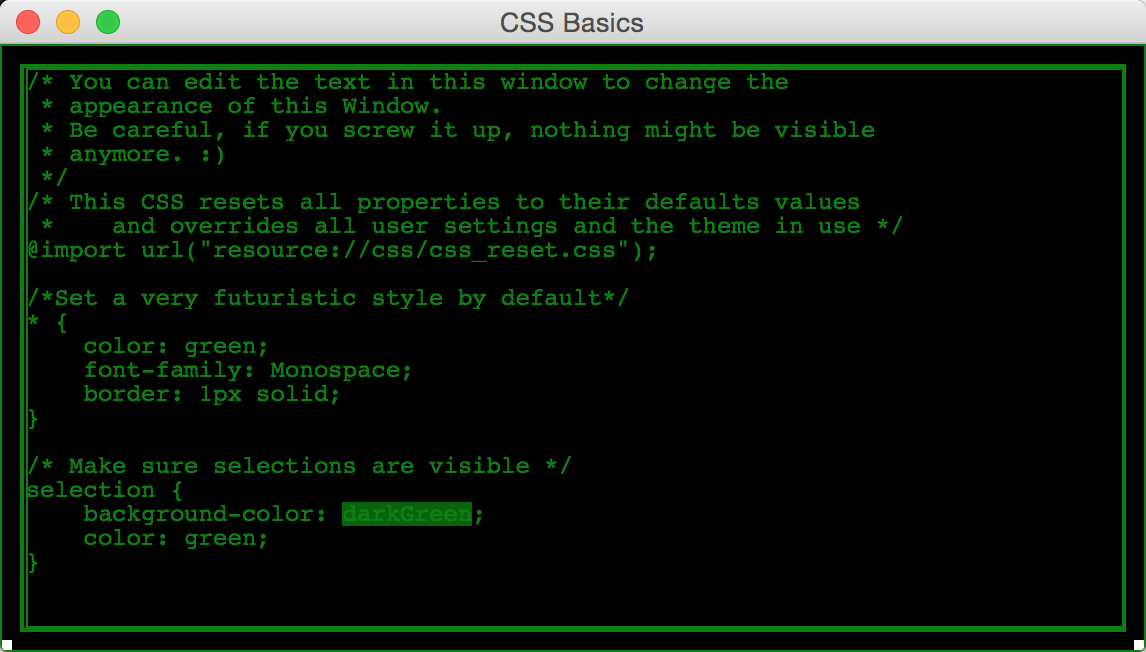例子
代码:
#!/usr/bin/env python3
# section 154
# -*- Mode: Python; py-indent-offset: 4 -*-
# vim: tabstop=4 shiftwidth=4 expandtab
#
# Copyright (C) 2013 Gian Mario Tagliaretti <gianmt@gnome.org>
#
# This library is free software; you can redistribute it and/or
# modify it under the terms of the GNU Lesser General Public
# License as published by the Free Software Foundation; either
# version 2.1 of the License, or (at your option) any later version.
#
# This library is distributed in the hope that it will be useful,
# but WITHOUT ANY WARRANTY; without even the implied warranty of
# MERCHANTABILITY or FITNESS FOR A PARTICULAR PURPOSE. See the GNU
# Lesser General Public License for more details.
#
# You should have received a copy of the GNU Lesser General Public
# License along with this library; if not, write to the Free Software
# Foundation, Inc., 51 Franklin St, Fifth Floor, Boston, MA 02110-1301
# USA
TITLE = "CSS Basics"
DESCRIPTION = """
Gtk themes are written using CSS. Every widget is build of multiple items
that you can style very similarly to a regular website.
"""
import os
import gi
gi.require_version('Gtk', '3.0')
from gi.repository import Gtk, Gdk, Pango, Gio, GLib
class CSSBasicsApp:
def __init__(self):
#: Store the last successful parsing of the css so we can revert
#: this in case of an error.
self.last_good_text = ''
#: Set when we receive a parsing-error callback. This is needed
#: to handle logic after a parsing-error callback which does not raise
#: an exception with provider.load_from_data()
self.last_error_code = 0
self.window = Gtk.Window()
self.window.set_title('CSS Basics')
self.window.set_default_size(400, 300)
self.window.set_border_width(10)
self.window.connect('destroy', lambda w: Gtk.main_quit())
self.infobar = Gtk.InfoBar()
self.infolabel = Gtk.Label()
self.infobar.get_content_area().pack_start(self.infolabel, False, False, 0)
self.infobar.set_message_type(Gtk.MessageType.WARNING)
scrolled = Gtk.ScrolledWindow()
box = Gtk.Box(orientation=Gtk.Orientation.VERTICAL)
box.pack_start(scrolled, expand=True, fill=True, padding=0)
box.pack_start(self.infobar, expand=False, fill=True, padding=0)
self.window.add(box)
provider = Gtk.CssProvider()
buffer = Gtk.TextBuffer()
buffer.create_tag(tag_name="warning", underline=Pango.Underline.SINGLE)
buffer.create_tag(tag_name="error", underline=Pango.Underline.ERROR)
buffer.connect("changed", self.css_text_changed, provider)
provider.connect("parsing-error", self.show_parsing_error, buffer)
textview = Gtk.TextView()
textview.set_buffer(buffer)
scrolled.add(textview)
bytes = Gio.resources_lookup_data("/css/css_basics.css", 0)
buffer.set_text(bytes.get_data().decode('utf-8'))
self.apply_css(self.window, provider)
self.window.show_all()
self.infobar.hide()
def apply_css(self, widget, provider):
Gtk.StyleContext.add_provider(widget.get_style_context(),
provider,
Gtk.STYLE_PROVIDER_PRIORITY_APPLICATION)
if isinstance(widget, Gtk.Container):
widget.forall(self.apply_css, provider)
def show_parsing_error(self, provider, section, error, buffer):
start = buffer.get_iter_at_line_index(section.get_start_line(),
section.get_start_position())
end = buffer.get_iter_at_line_index(section.get_end_line(),
section.get_end_position())
if error.code == Gtk.CssProviderError.DEPRECATED:
tag_name = "warning"
else:
tag_name = "error"
self.last_error_code = error.code
self.infolabel.set_text(error.message)
self.infobar.show_all()
buffer.apply_tag_by_name(tag_name, start, end)
def css_text_changed(self, buffer, provider):
start = buffer.get_start_iter()
end = buffer.get_end_iter()
buffer.remove_all_tags(start, end)
text = buffer.get_text(start, end, False).encode('utf-8')
# Ignore CSS errors as they are shown by highlighting
try:
provider.load_from_data(text)
except GLib.GError as e:
if e.domain != 'gtk-css-provider-error-quark':
raise e
# If the parsing-error callback is ever run (even in the case of warnings)
# load the last good css text that ran without any warnings. Otherwise
# we may have a discrepancy in "last_good_text" vs the current buffer
# causing section.get_start_position() to give back an invalid position
# for the editor buffer.
if self.last_error_code:
provider.load_from_data(self.last_good_text)
self.last_error_code = 0
else:
self.last_good_text = text
self.infobar.hide()
Gtk.StyleContext.reset_widgets(Gdk.Screen.get_default())
def main():
CSSBasicsApp()
Gtk.main()
if __name__ == '__main__':
base_path = os.path.abspath(os.path.dirname(__file__))
resource_path = os.path.join(base_path, '../Data/demo.gresource')
resource = Gio.Resource.load(resource_path)
Gio.resources_register(resource)
main()
css_basics.css
/* You can edit the text in this window to change the
* appearance of this Window.
* Be careful, if you screw it up, nothing might be visible
* anymore. :)
*/
/* This CSS resets all properties to their defaults values
* and overrides all user settings and the theme in use */
@import url("resource://css/css_reset.css");
/*设置默认的颜色,字体和边框*/
* {
color: green;
font-family: Monospace;
border: 1px solid;
}
/* 设置选中文本的颜色和背景颜色 */
selection {
background-color: darkGreen;
color: green;
}
代码解析:
跟上一个例子有所不同的是,这个代码使用一个TextView来显示css文件,并监听文本内容的改变,当文本内容改变时,使用
provider.load_from_data(text)重新加载CSS样式,当加载错误出现错误就会调用show_parsing_error()方法显示错误信息
provider.connect("parsing-error", self.show_parsing_error, buffer)

























 588
588











 被折叠的 条评论
为什么被折叠?
被折叠的 条评论
为什么被折叠?










